NRAO eNews
July 2008 • Vol. 1, Iss. 2
- Two Thumbs Up for Einstein, Again!
- ALMA Construction
- Observing with the VLA-EVLA Transition Array
- Prototype WIDAR Correlator Arrives
- Student Observing Support Awards
- The 2008 Synthesis Imaging Workshop
- NRAO Summer Student Program
- AUI/NRAO Radio Astronomy Image Contest
- Career Opportunities
- ALMA and the Universidad Técnica Fedrico Santa Maria
- NRAO Receives Bracewell Radio Astronomy Papers
- Hein Hvatum, 1923 - 2008
- Archive
- Contact the Editor
- Subscribe
- More Information
NRAO eNews: July 2008 • Volume 1, Issue 2
Two Thumbs Up for Einstein, Again!
Rene Breton (McGill University)
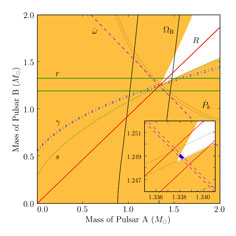
Mass-mass diagram illustrating the present tests constraining general relativity in the double pulsar PSR J0737-3039A/B. Because observations are consistent with general relativity, all lines intersect at common values of masses. Shaded orange regions are unphysical solutions because sin i ≤ 1, where i is the orbital inclination. The mass ratio, R, and five post-Keplerian parameters (s and r, Shapiro delay shape and range; ω., periastron advance; Pb., orbital period decay due to the emission of gravitational waves; and γ, gravitational redshift and time dilation) were reported by Kramer et al. (2006). The spin precession rate of pulsar B, ΩB, yields a new constraint on the mass-mass diagram.
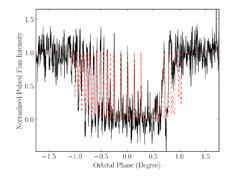
Average eclipse profile of pulsar A consisting of eight eclipses observed at 820 MHz over a 5-day period around 11 April 2007 (black line), and model eclipse profile (red dashed line). The resolution of each data point is ~91 ms while 1° in orbital phase corresponds to 24.5 s.
In forty years of radio pulsar astrophysics, binary pulsar research has built up an impressive pedigree of observational tests of gravitational theories, starring Einstein's general relativity upfront as the one theory yet to be defeated.
Binary pulsar tests of gravity yield their incredible success from two fundamental properties. First, radio pulsars emit periodic pulsations that can be timed to a precision that rivals, in some cases, the best atomic clocks. When found in binary systems, these frequency standards are ideal tools for studying orbital dynamics since the orbital Doppler shift is imprinted in the time of arrival of their pulses. Second, pulsars are extremely small and dense, and hence they dynamically behave like test-particles. Besides black holes, which represent obvious observational challenges, pulsar-neutron star binaries are the 'best' relativistic stellar systems that can be found in nature.
Traditional tests of general relativity involving binary pulsars are based on observations of their pulse arrival times. Relativistic effects give rise to several observable timing features that cannot be explained using Newtonian physics. Such measurements have been conducted in about a dozen binary pulsars, including the canonical PSR B1913+16, the first relativistic binary pulsar known (The 1993 Nobel Prize in Physics was awarded to its discoverers, Hulse and Taylor).
In early 2004, thirty years after PSR B1913+16 was found, the field of pulsar astronomy was rejuvenated with the discovery by Burgay et al. and Lyne et al. of the first and still only known pulsar-pulsar system. PSR J0737-3039A/B consists of a 23-ms pulsar orbiting a 2.8-s pulsar companion in a 2.4-h orbit, which makes it the most relativistic pulsar binary. In just two years of timing with the 100-meter NRAO Green Bank Telescope (GBT), the double pulsar permitted four independent tests of general relativity and other theories of gravity from the theory-independent measurement of the mass ratio of the system (via the timing of both pulsars) and the observation of five relativistic timing parameters (Kramer et al. 2006). One of these tests, involving the Shapiro shape parameter, already yielded the best constraint of general relativity in the strong gravitational field with 0.05% relative uncertainty.
The cosmic coincidence does not stop there: the double pulsar is seen almost edge-on and 30-s eclipses of the 23-ms pulsar (A) by its companion (B) are visible every orbit. These eclipses of pulsar A were rapidly recognized to be asymmetrical (Kaspi et al. 2004) and high time resolution analysis (McLaughlin et al. 2004) revealed narrow modulation features in the pulsed flux intensity that are synchronized with the rotational period of pulsar B, which passes in front.
Clearly, these eclipses contrast with anything seen before and were quite puzzling until Lyutikov and Thompson proposed a model mainly based on geometry. The radio emission from pulsar A is absorbed in pulsar B's magnetosphere via synchrotron resonance with relativistic electrons trapped in the closed field lines. The key in the Lyutikov and Thompson model is that, by assuming a dipolar geometry for the magnetosphere, it is possible to reproduce periodic features seen in the eclipse profile.
The Lyutikov and Thompson model also permits the spatial orientation of pulsar B to be inferred. This offers an unprecedented tool for investigating a relativistic effect induced by spin-orbit coupling terms in the Hamiltonian of the system that cause the spin axis of pulsar B to precess around the angular momentum of the system with a period of 71 years.
We have observed the double pulsar with the GBT since 2004 as part of a regular monitoring campaign aimed at timing the pulsars and studying phenomena such as eclipses. A total of 63 eclipses have been observed at 820 MHz, using the SPIGOT backend, that have allowed us to derive a highly significant relativistic precession rate of 4.77° (+0.65°, -0.66°) per year. This result agrees with the prediction of Einstein's theory of general relativity, which gives 5.07° per year. Furthermore, the fact that both pulsars can be timed independently permits us to obtain a theory-independent constraint of the ratio between the strength of the spin-orbit coupling and the generalized gravitational constant, σΒ/G, which provides another way of comparing it with general relativity: (σΒ/Gobs) / (σΒ/GGR) = 0.94 ± 0.13.
The GBT monitoring observations therefore set a new landmark for theories of gravity. Although more accurate tests of general relativity have been obtained in the past, this new one is qualitatively important; pulsars have large self-gravitating energy, and it is not excluded, in alternative theories of gravity, that spin would interact the same way in such an extreme environment.
What's next? Certainly, the obvious step is to continue double pulsar eclipse monitoring to obtain a more stringent measurement of the relativistic spin precession rate.
Many thanks to my scientific colleagues in this work: Victoria M. Kaspi (McGill University), Michael Kramer (Jodrell Bank Observatory), Maura A. McLaughlin (West Virginia University, NRAO), Maxim Lyutikov (Purdue University), Scott M. Ransom (NRAO), Ingrid H. Stairs (University of British Columbia), Robert D. Ferdman (University of British Columbia, Laboratoire de Physique et Chimie de l’Environnement), Fernando Camilo (Columbia University), Andrea Possenti (Istituto Nazionale di Astrofisica).
This research has been published as: "Relativistic Spin Precession in the Double Pulsar", Breton et al, Science, July 4, 2008, 321, 104.
Additional Multimedia Material
References:
Burgay, M. et al. 2003, Nature, 426, 531.
Lyne, A.G. et al. 2004, Science, 303, 1153.
Kramer, M. et al. 2006, Science, 314, 97.
Kaspi, V.M. et al. 2004, ApJ, 613, L137.
Lyutikov, M., & Thompson, C. 2005, ApJ, 634, 1223.
McLaughlin, M.A. et al. 2004, ApJ, 616, L131.
ALMA Construction
Al Wootten

July 7: An ALMA transporter moves a VertexRSI antenna for the first time, transporting it from inside the assembly building to an outside pad.
The ALMA Operations Support Facility Technical Building (OSF TB) has recently achieved Provisional Acceptance, and members of the ALMA teams working at the site will soon move into their new quarters. Nine ALMA antennas are now on-site in Chile: four antennas from Mitsubishi Electric Co. (Melco) and five antennas from VertexRSI. These antennas are undergoing acceptance testing, after which they will leave the contractor’s camp for further tests at the OSF TB, including radiometric tests using the first ALMA receiver suite. These receivers are contained within the ALMA Front End, the first of which was successfully tested at the OSF in June. Recent successful tests at the OSF featured a system that included ALMA elements from the Front End to the correlator and the software interconnecting these devices. The massive antennas are moved by one of the two ALMA transporters; the first of these achieved Provisional Acceptance and has moved the second assembled Vertex RSI antenna from the capacious (but with four antennas under construction, full) Site Erection Facility to an outside pad for holographic surface measurements. Later, a Melco antenna will be moved to the 16,400-foot elevation Array Operations Site (AOS) for high-altitude tests. Work is being completed on pad number 93, close to the AOS technical building, so that these tests may be efficiently accommodated.
Observing with the VLA-EVLA Transition Array
Gustaaf van Moorsel
In the June 2008 eNews we reported that in almost all cases spectral line data at 12.5 MHz bandwidth show a noise level too high by a factor of at least 2. We are still not entirely sure when this problem started to occur, but know it was some time after December 2006. Our earlier impression that turning off the correlator self- test eliminated the problem could not be confirmed by subsequent tests. Until further notice we therefore strongly recommend that all observers planning to use the 12.5 MHz bandwidth in their spectral line observations should select a different bandwidth.
For the latest news on this and other EVLA related items, please consult our EVLA returns web page.
Prototype WIDAR Correlator Arrives
Michael P. Rupen
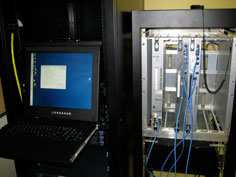
Figure 1: The Prototype Correlator for the EVLA in the old correlator room at the VLA site. The right-hand half-rack houses the correlator boards: two Station Boards to filter receive and sub-divide the data from two antennas, and one Baseline Board to perform the cross-correlations. The left-hand rack houses several associated general-purpose computers which control the correlator and process and archive the correlator output data. Two more Station Boards will be added over the next few weeks, giving four antenna and full closure capability.
The first set of boards for the prototype WIDAR correlator arrived at the VLA site on Tuesday, June 24, a week ahead of schedule. The WIDAR correlator is the backend for the Expanded Very Large Array (EVLA), and will cross-correlate the data from the individual antennas over up to 8 GHz of bandwidth in each polarization, divided into 128 independent sub-bands, at a spectral (channel) resolution ranging from 1 MHz to less than 0.1 Hz, with full pulsar binning and gating capabilities. These very demanding requirements are met by an impressively flexible and correspondingly complex design called Wideband Interferometric Digital Architecture (WIDAR).
The WIDAR correlator is the major contribution to the EVLA by Canada, through the Dominion Radio Astronomical Observatory (DRAO). The specially designed correlator chips (ASICs) and prototypes of the main boards have undergone extensive functional testing in the lab; the next step is to perform on-the-sky tests using real data from the antennas, before going to full-scale production. The primary purpose of the Prototype Correlator (PTC, Fig. 1) is to carry out those critical on-the-sky tests. The first boards will allow correlation of 0.8 GHz of bandwidth from two antennas. Boards to handle two additional antennas will be added in a few weeks. The critical tests will keep the DRAO and NRAO - Socorro staff busy for several months, working towards the WIDAR Critical Design Review this fall. Further details on the design and eventual capabilities of the full WIDAR correlator may be found in Chapter 8 of the EVLA Project Book.
Student Observing Support Awards
Carl Bignell, Dale Frail, and Joan Wrobel
on behalf of the Student Observing Support Committee
The Student Observing Support (SOS) Committee met in April 2008 to discuss the twelve proposals that were submitted during the last trimester. The committee, composed of five faculty members from U.S. universities, discussed the science case and student support application for each proposal and selected the following four proposals to receive funding.
Julia Deneva (Cornell, Supervisor: J. Cordes) was awarded $13,000 for work related to the GBT proposal (08B-017) “Uncovering the Galactic Center Pulsar Population: Spectrum Estimation and Timing of Two New Pulsars.”
Kyle Willet (U. Colorado, Supervisor: J. Darling) was awarded $35,000 for work related to the GBT proposal (08B-035) “A High Redshift OH Megamaser Survey.”
Fonda Day (U. New Mexico, Supervisor: Y. Pihlstrom) was awarded $33,200 for work related to the VLBA proposal (BP150) “Parallax and OH and H2O studies of Water Fountain PPNe.”
Steve Warren (U. Minnesota, Supervisor: E. Skillman) was awarded $29,000 for work related to the VLA Large proposal (AO215) “VLA and HST: Star Formation History and ISM Feedback in Nearby Galaxies.”
General information on the SOS program structure and background is available online in the "Introduction to the NRAO Student Observing Support Program."
The 2008 Synthesis Imaging Workshop
Amy Mioduszewski, for the Synthesis Imaging Workshop LOC
The Eleventh Synthesis Imaging Workshop was held from June 10-17, 2008, in Socorro, NM. Most of the workshop was held at Workman Center on the campus of the New Mexico Institute of Mining and Technology (NMIMT). The data tutorials were partially held at the NRAO Pete V. Domenici Science Operations Center in Socorro. There were four and a half days of lectures and one day of data reduction tutorials. Other events included a reception, dinner, hikes in the Magdalena Mountains and the Bosque del Apache, pool party and barbecue, and a very popular tour of the Very Large Array.
There were 139 registered participants from 16 countries ranging from Canada and Mexico to South Africa and Japan. Over half (63%) the participants were graduate students, the rest being scientific and engineering staff (14%), postdocs (10%), undergraduates (6%), faculty (5%), other (3%), and one high school teacher. Over a third (36%) of the participants were women.
New this year were both a reception on the evening of the first day of lectures and conducting some data reduction tutorials in NMIMT computer classrooms. Both were very successful and we hope to continue them in the future. Another change this year was the offer of three possible hikes; an "iron-man" hike in the Magdalena Mountains led by Rick Perley, a moderate hike in the Magdalena Mountains led by Craig Walker, and a bird-watching hike in the Bosque del Apache National Wildlife Refuge led by Eric Greisen.
Sixteen of the 24 lecturers were from NRAO. The Naval Research Lab contributed two lecturers and scientific staff personnel to run the low-frequency data reduction tutorial. There were two lecturers each from the University of New Mexico and the Harvard-Smithsonian Center for Astrophysics, and one each from the University of Iowa and MIT-Haystack. We thank all the lecturers for giving their time and talents to the workshop.
We would like to thank NRAO and AUI for providing logistical and financial support and the majority of the lecturers. We are deeply grateful to New Mexico Tech for providing financial support and use of their facilities, and particularly the NMIMT Physics department. We would also like to thank the University of New Mexico for financial and logistical support and the Institute for Advanced Studies at Los Alamos National Laboratory for financial support.
More information including photos, PowerPoint and PDF files of the lectures.
NRAO Summer Student Program
Toney Minter
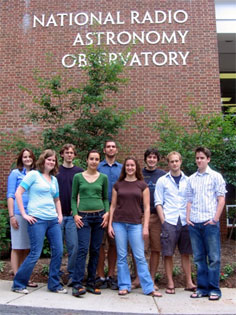
The Charlottesville Summer Students
Front Row L-R: Charli Sakari, Delia Mocanu, Evan Schneider, Daniel Lacasse
Back Row L-R: Jessica Coakley, Bryan Murphy, Tim Pennucci, Matt Schenker, Brian Sacash
Not in picture: Claudia Cyganowski, Allison Hammond, Anthony Hamzeh
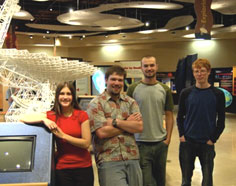
The Green Bank Summer Students
L-R: Stephanie Moats, Anthony Woody, Marc Eimers, Colin Slater
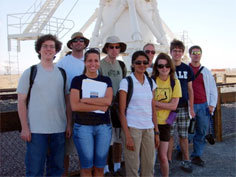
The Socorro Summer Students
Back Row L-R: Fred Davies, Josh Marvil, Ben Breslauer, Crystal Anderson, Alex Savello and Bobby Edmonds
Front Row L-R: Sarah Streb (Research Experiences for Teachers participant), Kiruthika Devaraj and Stephanie Capen
The 2008 summer student class has reported to their assigned NRAO sites. This year’s class consists of 24 students: 16 undergraduate students supported by the National Science Foundation "Research Experience for Undergraduates" (REU) program; 7 graduating seniors or graduate students supported by the NRAO Graduate or Undergraduate Summer Student program; and 1 high-school senior. Eight students are assigned to Socorro, twelve to Charlottesville, and four to Green Bank. These 24 students were chosen from 109 applications.
During their 10-12 week summer internships, the students will work with an NRAO mentor on a project in the mentor’s area of expertise. In addition to their research projects, the students will attend a lecture series and participate in field trips to other observatories. Students assigned to Socorro will collaborate on a VLA or VLBA observational project, while students assigned to Green Bank or Charlottesville will conduct observing projects with the GBT.
The accompanying table lists the names and schools of the 2008 NRAO summer students, together with their NRAO mentor, site, and project title.| Student | School | Project | Mentors | Site | Program |
| Daniel Lacasse | James Madison University | Web Image Gallery Refactoring | Pat Murphy | CV | NSF REU |
| Brian Sacash | Ohio Northern University | Data Preservation and Access for the NRAO 140ft and 12m Telescopes | Ron DuPlain | CV | NSF REU |
| Bryan Murphy | Virginia Polytechnic Institute and State University | Applying Semantic Web Technologies and Ontologies to the NRAO Data Vault | Nicole Radziwill | CV | NSF REU |
| Delia Mocanu | New Mexico Tech | Design Tool for Display of and Interaction with Large Spectral-Line GBT Data Sets | Bob Garwood | CV | NRAO uGRP |
| Jessica Coakley | Bridgewater College | The Star Formation Environment of Sharpless 106 | Jeff Mangum | CV | NSF REU |
| Matthew Schenker | Dartmouth College | Modeling Line Emission from Rotating Accretion Disks in AGNs | Jim Braatz | CV | NSF REU |
| Claudia Cyganowski | University of Wisconsin-Madison | Probing the Nature of Extended Green Objects: A New Sample of Massive Protostellar Candidates | Crystal Brogan | CV | NRAO GRP |
| Charli Sakari | Whitman College | Investigating the jets of Cygnus X-3 | James Miller-Jones | CV | NSF REU |
| Anthony Woody | West Virginia University Institute of Technology | A low EMI m&c interface for the K band Focal Plan Array Receiver | John Ford | GB | NSF REU |
| Marc Eimers | University of Colorado at Boulder | 140 Foot pulsar observation commissioning | Maura McLaughlin and Dunc Lorimer | GB | NSF REU |
| Stephanie Moats | New Mexico Tech | GBT searches for new classes of interstellar molecules | Glen Langston | GB | NSF REU |
| Colin Slater | Case Western Reserve University | Power Spectra of HI in the Outer Galaxy | Toney Minter | GB | NSF REU |
| Joshua Marvil | UCSB | Understanding the nature of the microJy radio source population | Frazer Owen | Soc | NRAO GRP |
| Alexander Savello | Emory University | Kinematic study of Bok globule CB4 | Robert Dickman | Soc | NSF REU |
| Stephanie Capen | Eastern Nazarene College | Infrared colors of evolved stars as a tracer of maser emission | Lorant Sjouwerman & Mark Claussen | Soc | NSF REU |
| Crystal Anderson | Western Washingtion University | X-ray emission from embedded young massive stars | Debra Shepherd | Soc | NRAO GRP |
| Kiruthika Devaraj | PSG College of Technology | Radio Observations and Radiative Transfer Modeling of Planetary Atmospheres | Brigette Hesman & Bryan Butler | Soc | NRAO GRP |
| Robert Edmonds | The University of New Mexico | The nature of the high-redshift tail of the submm galaxy population | Jeff Wagg & Chris Carilli | Soc | NRAO uGRP |
| Benjamin Breslauer | Oberlin College | Astronomy in the Time Domain | Dale Frail | Soc | NSF REU |
| Anthony Hamzeh | James Madison University | Probing the Physical and Chemical Properties of Astronomical Environments using Spectral Line Survey | Tony Remijan | CV | NSF REU |
| Evan Schneider | Bryn Mawr College | Searching for the Pulsar in SN1986J | Scott Ransom | CV | NSF REU |
| Frederick Davies | New Mexico Tech | Relative Motions of two Massive Galaxies in the Virgo Cluster | Craig Walker and Joan Wrobel | Soc | NSF REU |
| Timothy Pennucci | Columbia University, Columbia College | Dynamic Power Spectra: Searching for Compact Binary Pulsars | Scott Ransom | CV | NRAO uGRP |
| Allison Hammond | Western Albemarle High School | Parent and Daughter Species Evolution in Comet Hale-Bopp | Jeff Mangum | CV | Other |
AUI/NRAO Radio Astronomy Image Contest
Mark T. Adams
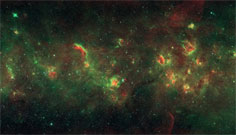
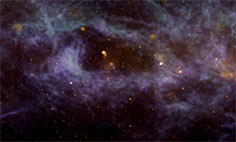
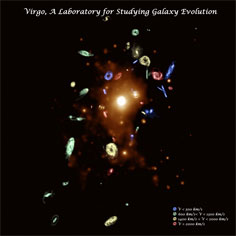
The First Prize images from the 2007, 2006, and 2005 AUI/NRAO Radio Astronomy Image Contests respectively.
The NRAO invites and encourages submissions of astronomical images to the 4th annual AUI/NRAO Radio Astronomy Image Contest. This contest is designed to promote research conducted by scientists using NRAO telescopes and increase the number of visually compelling, high-quality radio astronomy images available for education and public outreach (EPO). Images submitted to this contest will be included in the NRAO Image Gallery for use by scientists, teachers, the public, the media, and EPO professionals. Associated Universities, Inc. (AUI) sponsors the contest prizes, including a First Prize of $1000, a Second Prize of $500, a Third Prize of $250, and up to nine Honorable Mentions of $100 each. The submission deadline for the 2008 AUI/NRAO Radio Astronomy Image Contest is Wednesday, 3 September 2008.
Read detailed information regarding the contest and how to submit images.
Career Opportunities
ALMA Antenna Group Manager: The Joint ALMA Observatory is seeking a senior engineer to lead the ALMA Antenna Group, with responsibility for all activities associated with the reliable and effective operation of the antennas in the ALMA array.
ALMA Electronics Group Manager: The Joint ALMA Observatory is seeking a senior engineer to lead the ALMA Electronics Group, with responsibility for all activities associated with the reliable and effective operation of the ALMA electronics.
ALMA Test Scientists: The NRAO is seeking scientists to participate in the commissioning of the ALMA array in Chile. Test Scientists are expected and encouraged to conduct active astronomical research programs.
CASA Group Supervisor: The NRAO is seeking a suitably qualified professional to lead the team responsible for the design and development of the Common Astronomy Software Applications (CASA) that will be an integral part of the data post-processing for ALMA and EVLA.
ALMA and the Universidad Técnica Fedrico Santa Maria
Sergio Cabezon
If one examines the statistics of local personnel hired by AUI/NRAO for the ALMA project in Chile, one is quickly struck by the fact that nearly a quarter of the engineers and fully half of all ALMA technicians had their professional degrees conferred by the Universidad Técnica Federico Santa Maria (UTFSM) in Valparaiso, Chile.
The visionary businessman Federico Santa Maria, who wanted to transform how science and technology were taught in Chile, founded this excellent University in 1931.
On 27 June 2008, Eduardo Hardy, the AUI-NRAO representative in Chile and Assistant Director for Chilean Affairs was invited by the Centre of Innovation and Technology Transfer of the UTFSM to give a presentation on ALMA to students and faculty.
The purpose of this presentation was to detail the numerous scientific, professional, and technical opportunities offered by ALMA, and also to foster the interest of the University in developing astrophysics as a career.
Among the attendants was the University president as well as the Deans of academic departments, professors and students from the Engineering and Physics schools of this University. A collaborative agreement between NRAO and the UTFSM is now under development.
NRAO Receives Bracewell Radio Astronomy Papers
Ellen Bouton
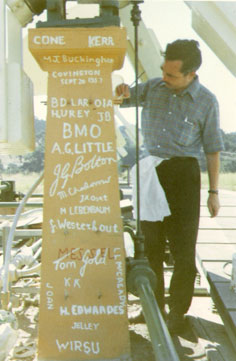
Ronald N. Bracewell touching up names incised by astronomers in a pier of one of the antennas in the spectroheliograph (Photo courtesy Bob Lash).
We are pleased to announce that the family of Ronald N. Bracewell (1921-2007) is donating Bracewell's radio astronomy papers to the NRAO Archives. The extensive collection, to be received over the next six to eight months, will include correspondence, technical reports, publications and manuscripts, photographs and moving images, and subject files.
Bracewell was born in Sydney in 1921. He received a B.Sc. in mathematics and physics from University of Sydney in 1941 then worked under Joseph L. Pawsey and Edward G. Bowen on development of microwave radar at the Radiophysics Laboratory of the Council for Scientific and Industrial Research. After World War II he received his PhD in physics from Cambridge University, then returned to the Radiophysics Laboratory where he focused on long wave propagation and radio astronomy. At Otto Struve's invitation, he lectured on radio astronomy in 1954-1955 at University of California - Berkeley, and he joined the Stanford University Electrical Engineering faculty in 1955. He retired in 1979, but continued active until his death.
At Stanford, Bracewell constructed a 32-dish microwave spectroheliograph in 1961 that automatically produced daily temperature maps of the sun for eleven years (one solar cycle). A second major radio telescope, an interferometer of five 60-ft dishes, was designed and built in 1971 to conduct solar and galactic studies.
In 1955, Pawsey and Bracewell co-authored “Radio Astronomy,” the first textbook in the field. Bracewell's “Fourier Transform and Its Applications” was published in three editions and translated into tens of languages. His interest in astronomical imaging led to his involvement in the development of computer-assisted X-ray tomography; Bracewell was on the founding editorial board of Journal of Computer-Assisted Tomography, lectured regularly on imaging, and in 1995 published “Two-Dimensional Imaging.” Bracewell's interests covered a broad range of topics outside astronomy and imaging: in 2005, e.g., the Stanford Historical Society published his book on “Trees of Stanford and Environs.”
Bracewell's radio astronomy papers will be an important addition to the NRAO Archives, and we are grateful to the Bracewell family for donating this significant collection.
Hein Hvatum, 1923 - 2008
Fred K. Y. Lo

Hein Hvatum, 1923 - 2008
It is with great sadness that I write of the passing of Hein Hvatum on Thursday, 22 May. Hein was one of the first NRAO staff members and was with the Observatory from 1962 until he retired. During his long and extraordinarily productive career at the NRAO, Hein Hvatum guided all of the technical activities at the NRAO, including telescope design, construction and maintenance, electronics, and computing.
Hein was born on April 17, 1923 in Tonsbery, Norway and received his undergraduate education at Vestheim School in Oslo and his PhD in electronic engineering from Chalmers University in Sweden in 1954. He arrived at the NRAO as a Research Associate in 1958; and after a brief return to Sweden, rejoined the NRAO as an Electronics Engineer in 1961. In 1962 he became Head of the Electronics Division and then Assistant Director and Associate Director for Technical Services in 1964 and 1972, respectively. During this time he became responsible for the successful completion of the 36-foot mm telescope on Kitt Peak. In 1974 Hein assumed responsibility for the construction of the VLA. In 1980 he became responsible for the 25 m telescope project, and in 1985 he became Project Manager for the VLBA, before retiring at the end of 1987. Hein also served as Acting NRAO Director in 1984.
Hein was active in both national and international programs for the protection of radio frequencies for radio astronomy. He was also an avid cyclist, and for many years, an active radio amateur who organized numerous community emergency preparation drills.
Hein was one of those giants who helped make the NRAO the premier radio astronomy observatory in the world.
 Zoom
Zoom

